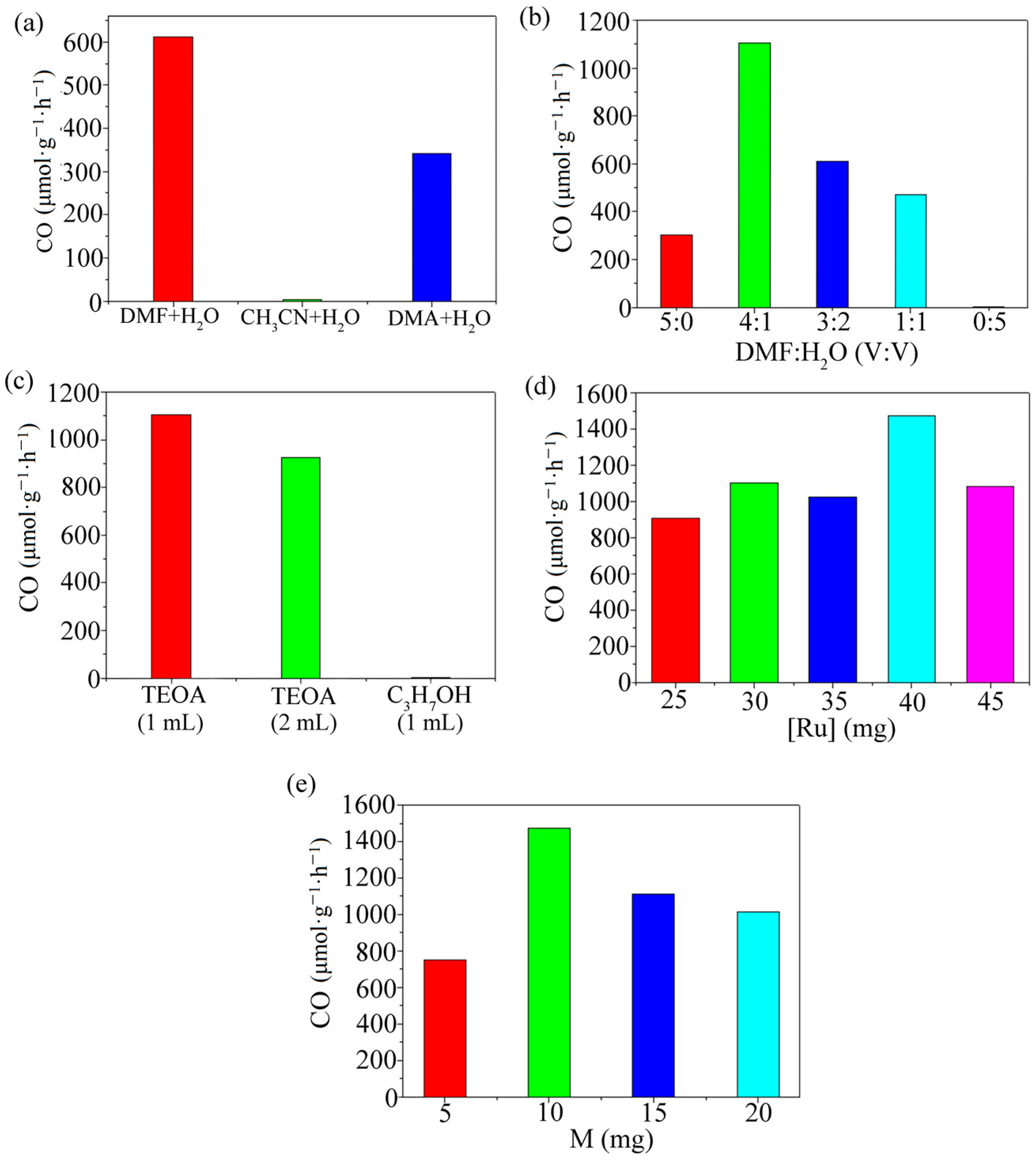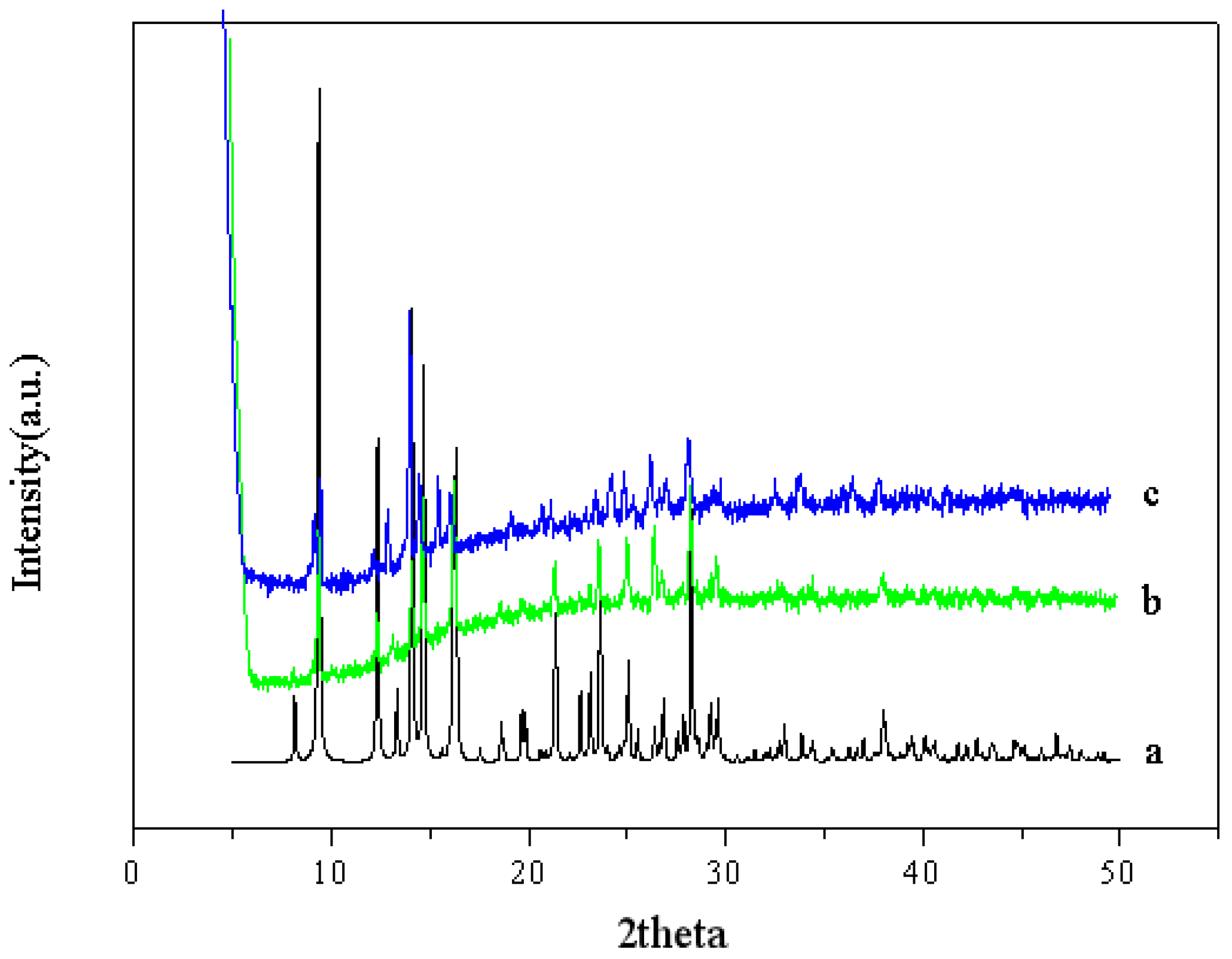Application of a Metal Cobalt Based on 4,6-Bis(imidazol-1-yl)isophthalicacid Metal-Organic -Framework Materials in Photocatalytic CO2 Reduction, Antibacterial, and Dye Adsorption
Abstract
:1. Introduction
2. Materials and Methods
2.1. Materials and Instrumentation
2.2. Synthesis of the MOF ([Co(bimip)(H2O)0.5]·0.5H2O)
2.3. Powder X-ray Diffraction (PXRD)
2.4. Optimum Reaction Conditions of Photocatalysis
2.5. Bacteriostatic Ring Experiment and Growth Curve
3. Results and Discussion
3.1. Photocatalytic CO2 Reduction
3.2. Antibacterial Properties
3.3. Adsorption Properties of the MOF to Dyes
4. Conclusions
Supplementary Materials
Author Contributions
Funding
Data Availability Statement
Conflicts of Interest
Sample Availability
References
- Rao, H.; Schmidt, L.C.; Bonin, J.; Robert, M. Visible-light-driven methane formation from CO2 with a molecular iron catalyst. Nature 2017, 548, 74–77. [Google Scholar] [CrossRef] [PubMed]
- Tu, W.; Zhou, Y.; Zou, Z. Photocatalytic Conversion of CO2 into Renewable Hydrocarbon Fuels: State-of-the-Art Accomplishment, Challenges, and Prospects. Adv. Mater. 2014, 26, 4607–4626. [Google Scholar] [CrossRef]
- Goeppert, A.; Czaun, M.; Jones, J.-P.; Surya Prakash, G.K.; Olah, G.A. Recycling of carbon dioxide to methanol and derived products-closing the loop. Chem. Soc. Rev. 2014, 43, 7995–8048. [Google Scholar] [CrossRef] [PubMed]
- Izumi, Y. Recent advances in the photocatalytic conversion of carbon dioxide to fuels with water and/or hydrogen using solar energy and beyond. Coord. Chem. Rev. 2013, 257, 171–186. [Google Scholar] [CrossRef]
- Inoue, T.; Fujishima, A.; Konishi, S.; Honda, K. Photoelectrocatalytic reduction of carbon dioxide in aqueous suspensions of semiconductor powders. Nature 1979, 277, 637–638. [Google Scholar] [CrossRef]
- Ong, W.J.; Putri, L.K.; Tan, Y.C.; Tan, L.L.; Li, N.; Ng, Y.H. Unravelling charge carrier dynamics in protonated g-C3N4 interfaced with carbon nanodots as co-catalysts toward enhanced photocatalytic CO2 reduction: A combined experimental and first-principles DFT study. Nano Res. 2017, 10, 1673–1696. [Google Scholar] [CrossRef]
- Shi, J.W.; Sun, D.K.; Zou, Y.J.; Ma, D.D.; He, C.; Ji, X. Trap-level-tunable Se doped CdS quantum dots with excellent hydrogen evolution performance without co-catalyst. Chem. Eng. J. 2019, 364, 11–19. [Google Scholar] [CrossRef]
- Wang, Z.; Domen, C.K. Recent developments in heterogeneous photocatalysts for solar-driven overall water splitting. Chem. Soc. Rev. 2019, 48, 2109–2125. [Google Scholar] [CrossRef]
- Lin, X.Z.; Wang, X.; Zhou, Q.W.; Wen, C.Y.; Su, S.; Xiang, J.; Cheng, P.; Hu, X.; Li, Y.; Wang, X.; et al. Magnetically Recyclable MoS2/Fe3O4 Hybrid Composite as Visible Light Responsive Photocatalyst with Enhanced Photocatalytic Performance. ACS Sustain. Chem. Eng. 2019, 7, 1673. [Google Scholar] [CrossRef]
- Zhao, H.; Wang, X.S.; Feng, J.F.; Chen, Y.N.; Yang, X. Synthesis and characterization of Zn2GeO4/Mg-MOF-74 composites with enhanced photocatalytic activity for CO2 reduction. Catal. Sci. Technol. 2018, 8, 1288–1295. [Google Scholar] [CrossRef]
- Yu, Y.; Zheng, W.; Cao, Y. TiO2–Pd/C composited photocatalyst with improved photocatalytic activity for photoreduction of CO2 into CH4. New J. Chem. 2017, 41, 3204–3210. [Google Scholar] [CrossRef]
- Raciti, D.; Wang, C. Recent advances in CO2 reduction electrocatalysis on copper. ACS Energy Lett. 2018, 3, 1545–1556. [Google Scholar] [CrossRef]
- Li, W.; Wang, H.; Jiang, X.; Zhu, J.; Liu, Z.; Guo, X.; Song, C. A short review of recent advances in CO2 hydrogenation to hydrocarbons over heterogeneous catalysts. RSC Adv. 2018, 8, 7651–7669. [Google Scholar] [CrossRef] [PubMed]
- North, M.; Pasquale, R.; Young, C. Synthesis of cyclic carbonates from epoxides and CO2. Green Chem. 2010, 12, 1514–1539. [Google Scholar] [CrossRef]
- Yu, J.; Low, J.; Xiao, W.; Zhou, P.; Jaroniec, M. Enhanced Photocatalytic CO2-Reduction Activity of Anatase TiO2 by Coexposed {001} and {101} Facets. J. Am. Chem. Soc. 2014, 136, 8839–8842. [Google Scholar] [CrossRef] [PubMed]
- Chen, H.; Nanayakkara, C.E.; Grassian, V.H. Titanium Dioxide Photocatalysis in Atmospheric Chemistry. Chem. Rev. 2012, 112, 5919–5948. [Google Scholar] [CrossRef]
- Wang, S.; Guan, B.; Lou, X.W.D. Rationally designed hierarchical N-doped carbon@NiCo2O4 double-shelled nanoboxes for enhanced visible light CO2 reduction. Energy Environ. Sci. 2018, 11, 306–310. [Google Scholar] [CrossRef]
- Wang, S.; Ding, Z.; Wang, X. A stable ZnCo2O4 cocatalyst for photocatalytic CO2 reduction. Chem. Commun. 2015, 51, 1517–1519. [Google Scholar] [CrossRef]
- Wang, Y.; Huang, N.Y.; Shen, J.Q.; Liao, P.Q.; Chen, X.M.; Zhang, J.P. Hydroxide Ligands Cooperate with Catalytic Centers in Metal-Organic Frameworks for Efficient Photocatalytic CO2 Reduction. J. Am. Chem. Soc. 2018, 140, 38–41. [Google Scholar] [CrossRef]
- Hong, D.; Tsukakoshi, Y.; Kotani, H.; Ishizuka, T.; Kojima, T. Visible-Light-Driven Photocatalytic CO2 Reduction by a Ni(II) Complex Bearing a Bioinspired Tetradentate Ligand for Selective CO Production. J. Am. Chem. Soc. 2017, 139, 6538–6541. [Google Scholar] [CrossRef]
- Matsubara, Y.; Grills, D.C.; Kuwahara, Y. Thermodynamic aspects of electrocatalytic CO2 reduction in acetonitrile and with an ionic liquid as solvent or electrolyte. ACS Catal. 2015, 5, 6440–6452. [Google Scholar] [CrossRef]
- Ju, Z.; Cao, D.; Qin, L.; Zhang, C.; Zhang, M.; Shi, Z.; Zheng, H. Syntheses, characterization, and properties of five coordination compounds based on the ligand tetrakis(4-pyridyloxymethylene)methane. CrystEngComm 2014, 16, 3917–3925. [Google Scholar] [CrossRef]
- Zhang, L.; Hu, Y.H. Structure distortion of Zn4O13C24H12 framework (MOF-5). Mater. Sci. Eng. B 2011, 176, 573–578. [Google Scholar] [CrossRef]
- Zhang, T.; Lin, W. Metal-organic frameworks for artifificial photosynthesis and photocatalysis. Chem. Soc. Rev. 2014, 43, 5982–5993. [Google Scholar] [CrossRef] [PubMed]
- Horcajada, P.; Gref, R.; Baati, T.; Allan, P.K.; Maurin, G.; Couvreur, P.; Férey, G.; Morris, R.E.; Serre, C. Metal-organic frameworks in biomedicine. Chem. Rev. 2012, 112, 1232–1268. [Google Scholar] [CrossRef]
- Karimi, A.R.; Beheshti, S.; Akhbari, K.; Morsali, A. Investigation of Reasons for Metal-organicFramework’s Antibacterial Activities. Polyhedron 2018, 156, 257–278. [Google Scholar] [CrossRef]
- Hu, Y.H.; Zhang, L. Hydrogen storage in metal–organic frameworks. Adv. Mater. 2010, 22, E117–E130. [Google Scholar] [CrossRef]
- Yin, H.Q.; Yin, X.B. Metal-Organic Frameworks with Multiple Luminescence Emissions: Designs and Applications. Acc. Chem. Res. 2020, 53, 485–495. [Google Scholar] [CrossRef]
- Gao, Q.; Xu, J.; Cao, D.; Chang, Z.; Bu, X.H. A Rigid Nested Metal-Organic Framework Featuring a Thermoresponsive Gating Effect Dominated by Counterions. Angew. Chem. Int. Ed. 2016, 55, 15027–15030. [Google Scholar] [CrossRef]
- Dai, F.N.; Wang, X.K.; Zheng, S.H.; Sun, J.P.; Huang, Z.D.; Xu, B. Toward high-performance and flexible all-solid-state micro-supercapacitors: MOF bulk vs. MOF Nanosheets. Chem. Eng. J. 2020, 12, 127520. [Google Scholar] [CrossRef]
- Wang, D.; Huang, R.; Liu, W.; Sun, D.; Li, Z. Fe-based MOFs for photocatalytic CO2 reduction: Role of coordination unsaturated sites and dual excitation pathways. ACS Catal. 2014, 4, 4254–4260. [Google Scholar] [CrossRef]
- Zhang, H.; Wei, J.; Ye, J.; Dong, J.C.; Liu, G.G.; Shi, L.; An, P.F.; Zhao, G.X.; Kong, J.T.; Wang, X.J.; et al. Efficient Visible-Light-Driven Carbon Dioxide Reduction by a Single-Atom Implanted Metal-Organic Framework. Angew. Chem. Int. Ed. Engl. 2016, 55, 14310–14314. [Google Scholar] [CrossRef] [PubMed]
- Li, P.; Hou, C.C.; Zhang, X.H.; Chen, Y.; He, T. Ethylenediamine-functionalized CdS/tetra(4-carboxyphenyl) porphyrin iron(III) chloride hybrid system for enhanced CO2 photoreduction. Applied Surface Science 2018, 459, 292–299. [Google Scholar] [CrossRef]
- Guo, J.J.; Wang, K.; Wang, X.T. Photocatalytic reduction of CO2 with H2O vapor under visible light over Ce doped ZnFe2O4. Catal. Sci. Technol. 2017, 7, 6013–6025. [Google Scholar] [CrossRef]
- Long, D.; Li, X.Y.; Yin, Z.F.; Fan, S.Y.; Wang, P.L.; Xu, F.Q.; Wei, L.; Tadé, M.O.; Liu, S.M. Novel Co3O4@CoFe2O4 double-shelled nanoboxes derived from Metal-Organic Framework for CO2 reduction. J. Alloys Compd. 2021, 854, 156942. [Google Scholar] [CrossRef]
- Wang, Y.N.; Zeng, Y.Q.; Wan, S.P.; Zhang, S.L.; Zhong, Q. Construction of octahedral BiFeWOx encapsulated in hierarchical In2S3 core@shell heterostructure for visible-light-driven CO2 reduction. J. CO2 Util. 2019, 29, 156–162. [Google Scholar] [CrossRef]
- Quirós, J.; Boltes, K.; Aguado, S.; de Villoria, R.G.; Vilatela, J.J.; Rosal, R. Antimicrobial metal-organic frameworks incorporated into electrospun fibers. Chem. Eng. J. 2015, 262, 189–197. [Google Scholar] [CrossRef]
- Brogan, D.; Mossialos, M.E. A Critical Analysis of the Review on Antimicrobial Resistance Report and the Infectious Disease Financing Facility. Glob. Health 2016, 12, 8. [Google Scholar] [CrossRef]
- Hemeg, H.A. Nanomaterials for alternative antibacterial therapy. Int. J. Nanomed. 2017, 12, 8211–8225. [Google Scholar] [CrossRef]
- Santo, C.E.; Quaranta, D.; Grass, G. Antimicrobial metallic copper surfaces kill Staphylococcus haemolyticus via membrane damage. Microbiol. Open 2012, 1, 46–52. [Google Scholar] [CrossRef]
- Liu, Y.; Xu, X.; Xia, Q.; Yuan, G.; He, Q.; Cui, Y. Multiple topological isomerism of three-connected networks in silver-based metal-organoboron frameworks. Chem. Commun. 2010, 46, 2608–2610. [Google Scholar] [CrossRef] [PubMed]
- Shams, S.; Ahmad, W.; Memon, A.H.; Shams, S.; Wei, Y.; Yuan, Q.W.; Liang, H. Cu/H3BTC MOF as a potential antibacterial therapeutic agent against Staphylococcus aureus and Escherichia coli. New J. Chem. 2020, 44, 17671–17678. [Google Scholar] [CrossRef]
- Abbasi, A.R.; Akhbari, K.; Morsali, A. Dense coating of surface mounted CuBTC Metal-Organic Framework nanostructures on silk fibers, prepared by layer-by-layer methodunder ultrasound irradiation with antibacterial activity. Ultrason. Sonochem. 2012, 19, 846–852. [Google Scholar] [CrossRef] [PubMed]
- Restrepo, J.; Serroukh, Z.; Santiago-Morales, J.; Aguado, S.; Gómez-Sal, P.; Mosquera, M.E.G.; Rosal, R. An Antibacterial Zn-MOF with Hydrazinebenzoate Linkers. Berichte Der Dtsch. Chem. Gesellschaft. 2017, 3, 574–580. [Google Scholar] [CrossRef]
- Alshammari, M.S.; Essawy, A.A.; El-Nggar, A.M.; Sayyah, S.M. Ultrasonic-Assisted Synthesis and Characterization of Chitosan-Graft-Substituted Polyanilines: Promise Bio-Based Nanoparticles for Dye Removal and Bacterial Disinfection. J. Chem. 2020, 3297184. [Google Scholar] [CrossRef]
- Zhao, S.Q.; Chen, D.; Wei, F.H.; Chen, N.N.; Liang, Z.; Luo, Y. Removal of Congo red dye from aqueous solution with nickel-based metal-organic framework/graphene oxide composites prepared by ultrasonic wave-assisted ball milling. Ultrason. Sonochem. 2017, 39, 845–852. [Google Scholar] [CrossRef]
- Li, Y.Z.; Liu, Y.; Lu, Y.K.; Ma, L.N.; Hou, L.; Wang, Y.Y. Three New MOFs Induced by Organic Linker Coordination Modes: Gas Sorption, Luminescence, and Magnetic Properties. Chem. Asian J. 2019, 14, 2988–2994. [Google Scholar] [CrossRef]
- Zhang, J.H.; Zhong, D.C.; Lu, T.B. Co(II)-Based Molecular Complexes for Photochemical CO2 Reduction. Acta Phys.-Chim. Sin. 2021, 37, 2008068. [Google Scholar]






| Entry | [MOF] mg | [{Ru(bpy)3}2+] mg | TEOA mL | CO μmol·g−1·h−1 |
|---|---|---|---|---|
| 1 | 10 | 40 | 1 | 2030.26 |
| 2 | 0 | 40 | 1 | 177.52 |
| 3 | 10 | 0 | 1 | 4.13 |
| 4 | 10 | 40 | 0 | 1.37 |
| 5 a | 10 | 40 | 1 | 0 |
| 6 b | 10 | 40 | 1 | 0 |
Disclaimer/Publisher’s Note: The statements, opinions and data contained in all publications are solely those of the individual author(s) and contributor(s) and not of MDPI and/or the editor(s). MDPI and/or the editor(s) disclaim responsibility for any injury to people or property resulting from any ideas, methods, instructions or products referred to in the content. |
© 2023 by the authors. Licensee MDPI, Basel, Switzerland. This article is an open access article distributed under the terms and conditions of the Creative Commons Attribution (CC BY) license (https://creativecommons.org/licenses/by/4.0/).
Share and Cite
Han, Y.; Zhao, L.; Jing, H.; Song, G.; Wang, Z.; Li, J.; Yang, Y. Application of a Metal Cobalt Based on 4,6-Bis(imidazol-1-yl)isophthalicacid Metal-Organic -Framework Materials in Photocatalytic CO2 Reduction, Antibacterial, and Dye Adsorption. Polymers 2023, 15, 3848. https://doi.org/10.3390/polym15183848
Han Y, Zhao L, Jing H, Song G, Wang Z, Li J, Yang Y. Application of a Metal Cobalt Based on 4,6-Bis(imidazol-1-yl)isophthalicacid Metal-Organic -Framework Materials in Photocatalytic CO2 Reduction, Antibacterial, and Dye Adsorption. Polymers. 2023; 15(18):3848. https://doi.org/10.3390/polym15183848
Chicago/Turabian StyleHan, Yue, Lun Zhao, Hongwei Jing, Guanying Song, Ziyun Wang, Jiayu Li, and Yi Yang. 2023. "Application of a Metal Cobalt Based on 4,6-Bis(imidazol-1-yl)isophthalicacid Metal-Organic -Framework Materials in Photocatalytic CO2 Reduction, Antibacterial, and Dye Adsorption" Polymers 15, no. 18: 3848. https://doi.org/10.3390/polym15183848
APA StyleHan, Y., Zhao, L., Jing, H., Song, G., Wang, Z., Li, J., & Yang, Y. (2023). Application of a Metal Cobalt Based on 4,6-Bis(imidazol-1-yl)isophthalicacid Metal-Organic -Framework Materials in Photocatalytic CO2 Reduction, Antibacterial, and Dye Adsorption. Polymers, 15(18), 3848. https://doi.org/10.3390/polym15183848






